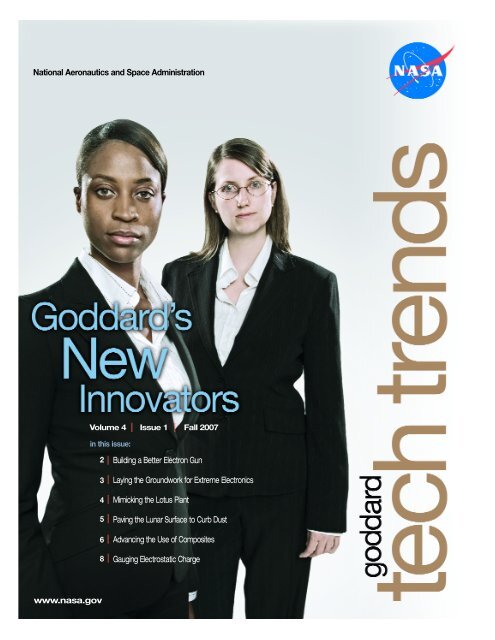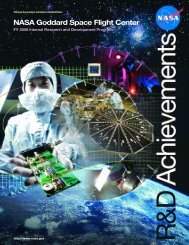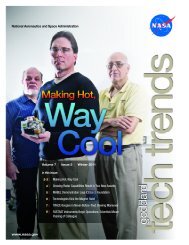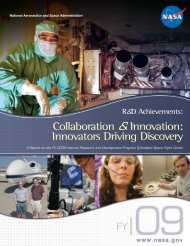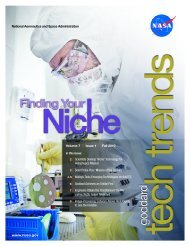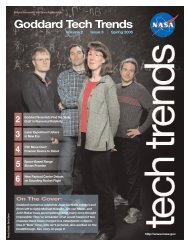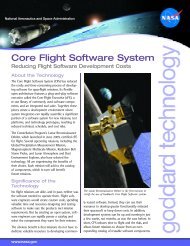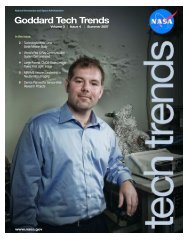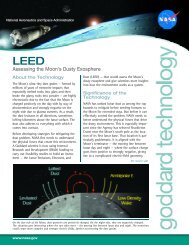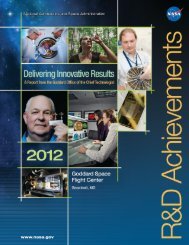Fall 2007 - NASA's Goddard Technology Management Office Home
Fall 2007 - NASA's Goddard Technology Management Office Home
Fall 2007 - NASA's Goddard Technology Management Office Home
Create successful ePaper yourself
Turn your PDF publications into a flip-book with our unique Google optimized e-Paper software.
National Aeronautics and Space Administration<br />
Volume 4 Issue 1 <strong>Fall</strong> <strong>2007</strong><br />
in this issue:<br />
2<br />
3<br />
4<br />
5<br />
6<br />
8<br />
Building a Better Electron Gun<br />
Laying the Groundwork for Extreme Electronics<br />
Mimicking the Lotus Plant<br />
Paving the Lunar Surface to Curb Dust<br />
Advancing the Use of Composites<br />
Gauging Electrostatic Charge<br />
w w w. n a s a . g o v
02<br />
Building a Better Electron Gun<br />
Carbon-Nanotube <strong>Technology</strong> Shows Promise for Next-Generation Mass Spectrometers<br />
Spacecraft instruments have followed a technologydevelopment<br />
trajectory similar to computers.<br />
Through advances in technology, they have become<br />
smaller and lighter. But assuring a berth on future<br />
NASA missions will require scientists and engineers to<br />
shrink them even more.<br />
Stephanie Getty, a materials engineer in the <strong>Goddard</strong><br />
Materials Engineering Branch who was hired in 2004<br />
specifically to apply nanotechnology solutions to<br />
instrument designs, has found a promising approach<br />
that could assure <strong>Goddard</strong>’s leadership in the field of<br />
mass spectrometry, a technique scientists use to<br />
determine the composition and abundance of atoms<br />
in a molecular substance.<br />
She is now working with scientists in <strong>Goddard</strong>’s<br />
Atmospheric Experiments Laboratory and engineers<br />
in <strong>Goddard</strong>’s Materials Engineering and Detector<br />
Systems Branches to develop a miniaturized “electron<br />
gun” for a next-generation, time-of-flight mass<br />
s p e c t r o m e t e r. In electron-impact-ionization mass<br />
s p e c t r o m e t ry, the electron gun is the heart of the<br />
i n s t rument. It produces and focuses an electron<br />
beam that ionizes gas molecules so that the spectrometer<br />
can measure their masses and ultimately<br />
d e t e rmine the molecules’ chemical make u p .<br />
The team’s ultimate goal is to eventually create a<br />
mass spectrometer that would be about as large<br />
as a CD case and consume less power than a<br />
clock radio (about 1 watt). In contrast, the<br />
<strong>Goddard</strong>-developed mass spectrometer that flew<br />
on the Huygens probe was roughly the size and<br />
weight of a bowling ball and consumed as much<br />
power as a small light bulb, which at the time was<br />
considered a significant engineering feat.<br />
C o n t i n u e d , Page 7<br />
On The Cover:<br />
In September, Center Director Ed Weiler announced that 85 research proposals had<br />
won funding under <strong>Goddard</strong>’s FY08 Internal Research and Development program.<br />
Twenty-three percent represented ideas offered by new innovators — defined as<br />
persons with no more than 7 years of professional experience. In this issue,<br />
<strong>Goddard</strong> Tech Trends showcases the work of two new <strong>Goddard</strong> innovators, La Vida<br />
Cooper (left) and Stephanie Getty (right), whose innovative work may one day help<br />
NASA to dramatically reduce the size and mass of spacecraft systems and components.<br />
In all respects, these two women represent the future of NASA.<br />
Photo Credit: Chris Gunn<br />
h t t p : / / g s f c t e c h n o l o g y. g s f c . n a s a . g o v Volume 4 Issue 1 <strong>Fall</strong> <strong>2007</strong>
Extreme Electronics<br />
<strong>Goddard</strong> Innovator Lays Groundwork for Developing Cold-Tolerant ASICs<br />
Designing and developing a complex<br />
integrated circuit that operates at room<br />
temperature is difficult enough. Now<br />
imagine trying to craft one that can withstand<br />
the harsh temperatures found in<br />
space. It’s not easy.<br />
“Right now, we don’t fully understand<br />
how each component or piece reacts to<br />
s u p e r-cold temperatures or how it will<br />
fit together with other components as a<br />
system when exposed to extreme environments,”<br />
says La Vida Cooper, an electronics<br />
engineer. She has won Intern a l<br />
Research and Development (IRAD)<br />
funding to learn how they behave. The<br />
aim is to give <strong>Goddard</strong> electronics engineers<br />
the models they need to more<br />
efficiently design application-specific<br />
integrated circuits (ASICs) that carry out<br />
a particular task even when exposed to<br />
harsh temperatures.<br />
The pay-off for NASA could be significant.<br />
It could assist the Agency in its<br />
goal to further miniaturize spacecraft<br />
and instru m e n t s .<br />
To d a y, spacecraft electronics are typically<br />
placed inside a protective, therm a l l y<br />
controlled enclosure that takes up more<br />
mass, says Mike Johnson, an assistant<br />
chief for technology for <strong>Goddard</strong>’s<br />
Electrical Engineering Division. “W h a t<br />
we’d like to do is get rid of that enclosure and develop<br />
electronics that can operate under extremely cold temperatures,”<br />
he says.<br />
Paucity of Standards<br />
At this stage, however, getting rid of that box isn’t a<br />
viable option. Curr e n t l y, industry standards are based on<br />
components operating over a fairly limited temperature<br />
range — not the extremes found in space, Johnson says.<br />
Therefore, it takes engineers longer to design the complicated<br />
circuits because they can’t accurately predict how<br />
the individual transistors — the tiny components that<br />
m a ke up an integrated circuit — will behave under<br />
significantly colder conditions. The lack of models also<br />
hinders simulation testing, an important step in ASIC<br />
development.<br />
C o n t i n u e d , Page 8<br />
03<br />
Spotlight: La Vida Cooper<br />
Having already earned two undergraduate degrees in<br />
physics and electrical engineering, the conundrum La Vida<br />
Cooper faced in the summer of 2003 before continuing at<br />
Johns Hopkins University in pursuit of a masters in electrical<br />
and computer engineering was what would she do next?<br />
She accepted a summer opportunity with the NASA<br />
A c a d e m y, followed by a co-op position, and knew immediately<br />
that NASA would be a good fit. In 2005, Cooper<br />
became a full-time employee with <strong>Goddard</strong>’s<br />
Microelectronics and Signal Processing Branch. She says her<br />
work is living up to her expectations.<br />
“ First and foremost, I like the fact that there is always a challenging<br />
problem to solve or an unanswered question to<br />
p o n d e r. Even if a solution exists, there is always room for<br />
improvement. It’s great to be surrounded by people who<br />
are willing to embrace new ideas, and are not easily discouraged<br />
in the face of temporary obstacles or setbacks.” ◆<br />
Volume 4 Issue 1 <strong>Fall</strong> <strong>2007</strong><br />
h t t p : / / g s f c t e c h n o l o g y. g s f c . n a s a . g o v
04<br />
NASA has ra n ked lunar dust as<br />
among the top hazards to mitigate<br />
befo re sending humans to<br />
the Moon for extended stays —<br />
and for good re a s o n . Barbed and<br />
e l e c t ro s t a t i c a l ly charge d , t h e s e<br />
u l t ra - t i ny dust part i cles cling to<br />
eve ry t h i n g , much like Styro fo a m<br />
p e a nuts used for packing.Th ey<br />
can gum up machinery, d a m a ge space suits, a n d<br />
wo rs e , find their way into astro n a u t s ’ living quart e rs ,<br />
Taking On<br />
Moondust<br />
which could cause long-term<br />
health pro blems for inhab i t a n t s .<br />
For the past couple ye a rs ,<br />
G o d d a rd ’s Internal Research and<br />
D evelopment (IRAD) pro gra m<br />
has funded innova t i ve ideas<br />
aimed at understanding the<br />
p hysics that create the dusty env i-<br />
ronment and finding ways to<br />
m i t i gate it.G o d d a rd Tech Trends spotlights a few of<br />
those technologies in this issue.<br />
Mimicking the Self-Cleaning Lotus Plant<br />
<strong>Goddard</strong> Researchers Investigate ‘Lotus Coatings’ for Use in Space<br />
The lotus plant has<br />
inspired one<br />
<strong>Goddard</strong> aerospace<br />
engineer to develop a<br />
special coating that<br />
would mimic the<br />
plant’s unusual selfcleaning<br />
propert i e s<br />
and help prevent the<br />
Moon’s powdery grit from accumulating on astronauts<br />
and their gear.<br />
Wanda Peters is working with an Atlanta-based company,<br />
nGimat, to determine whether the two “lotus coatings”<br />
that the company has developed in collaboration with<br />
Georgia Tech would work on the lunar surface.<br />
The lotus plant, which lives along muddy waterways in<br />
Asia, is well known for its ultra-hydrophobic nature.<br />
Despite living in muddy conditions, the plant’s leaves and<br />
flowers remain clean because they are composed of<br />
micron- and nano-scale structures that prevent dirt and<br />
water from adhering. Water droplets literally roll off, taking<br />
mud and tiny insects with them.<br />
Widespread Application<br />
The ability to replicate these properties could prove<br />
invaluable to NASA, says Peters, who heads <strong>Goddard</strong>’s<br />
Coatings Engineering Group. The Agency could coat<br />
spacesuits, radiators, solar arrays, and other equipment<br />
with the material to repel dust and prevent it from accumulating.<br />
“The question we need to answer is whether<br />
we can really get a lotus coating to work in real life.”<br />
So far, environmental test results on nGimat’s two form u-<br />
lations are promising. Both have maintained their part i-<br />
cle-shedding properties even when exposed to harsh<br />
ultraviolet light and other space-like conditions. However,<br />
she and her team have had trouble consistently reproducing<br />
the formulas. Consequently, Peters said she is<br />
Wanda Peters holds a coating-covered sample that she<br />
and her team are currently testing to determine the coati<br />
n g ’s appropriateness for use on the Moon.<br />
considering developing her own coating in parallel with<br />
her current research.<br />
Although she has high hopes for eventually producing a<br />
space-qualified lotus coating, she concedes that it’s only<br />
one of several strategies NASA will need to employ to<br />
m a ke living and working on the Moon tolerable. Some<br />
s u p e r-fine dust particles still will find their way into astronauts’<br />
living quarters. Consequently, Peters also is looking<br />
at other cleaning technologies, including air showers and<br />
vibration, to repel dust.<br />
“Habitation areas on the Moon will be like any house.<br />
They will get dusty,” she says. But given the environmental<br />
hazards posed by moondust, “we’ll need to minimize it<br />
as much as possible.” ◆<br />
C o n t a c t :<br />
Wa n d a . C . Peters@nasa.gov or 301.286.5147<br />
h t t p : / / g s f c t e c h n o l o g y. g s f c . n a s a . g o v Volume 4 Issue 1 <strong>Fall</strong> <strong>2007</strong>
T a k i n g O n M o o n d u s t<br />
How to Solve the Lunar Dust Problem? Pave the Surface<br />
<strong>Goddard</strong> technologist<br />
Eric Cardiff offers an<br />
unusual solution to<br />
help diminish the dust<br />
dilemma on the Moon:<br />
pave the area around a<br />
lunar base using nothing<br />
more than focused<br />
s u n l i g h t .<br />
05<br />
Cardiff is developing a<br />
prototype of a fourwheeled<br />
vehicle that<br />
would use a lens to<br />
focus sunlight onto the<br />
lunar surface. The sunlight-generated<br />
heat<br />
would melt or sinter<br />
the dust to create a<br />
hardened surface.<br />
The current design<br />
employs a Fresnel lens,<br />
a very lightweight optic<br />
that bends light the<br />
same way as a norm a l<br />
lens, but takes up significantly<br />
less mass. Fo r<br />
operations at NASA’ s<br />
proposed polar base<br />
near Shackleton Crater,<br />
the so-called Dust<br />
Mitigation Ve h i c l e<br />
(DMV) also would<br />
need a primary mirr o r<br />
to reflect the sunlight from the near-horizontal angle of<br />
the Sun onto the Fresnel lens.<br />
University of Maryland student Brandon Hall and Principal Investigator Eric Card i ff are using<br />
R&D funds to develop a prototype of a so-called Dust Mitigation Vehicle, which would help<br />
c o n t rol the lunar dust problem by melting the regolith around habitat areas.<br />
Inspired by a Previous IRAD Investigation<br />
Cardiff conceived the idea while working on an earlier<br />
I R A D-funded technique called vacuum pyrolysis to extract<br />
oxygen from the lunar soil. That early concept also made<br />
use of a Fresnel lens, which concentrated sunlight before<br />
it passed through a window and into a vacuum chamber<br />
where the light ultimately heated and melted the regolith,<br />
releasing small amounts of oxygen. From his research, he<br />
discovered that lunar soil melted at relatively low temperatures,<br />
giving birth to the possible dust-mitigation strategy.<br />
Cardiff admits that the idea of melting dust isn’t new. A<br />
University of Tennessee professor has been working on<br />
similar applications using microwave-heating techniques.<br />
H o w e v e r, the professor’s concept would require substantially<br />
more power, which means that his device would<br />
have to be tethered to a power source or would have to<br />
c a rry very large and heavy solar panels. Cardiff also says<br />
that the technique isn’t as efficient. Only half of the energy<br />
put into the microwave emitters is released as<br />
microwave radiation, which means that the vehicles<br />
would have to carry large radiators for the “waste heat.”<br />
The advantage of DMV, he says, is that it’s lightweight<br />
(less than 110 lbs. or 50 kg), requires little power, and<br />
could even be used as a science platform. As the top layers<br />
melted, the DMV could measure the regolith’s physical<br />
properties as well as its embedded gases.<br />
The DMV was built as a remote-controlled prototype. It is<br />
being tested at the <strong>Goddard</strong> Propulsion Test Site over simulated<br />
lunar dust to see how fast the DMV can really work. ◆<br />
C o n t a c t :<br />
Eric.H.Cardiff@nasa.gov or 301.286.0388<br />
Volume 4 Issue 1 <strong>Fall</strong> <strong>2007</strong><br />
h t t p : / / g s f c t e c h n o l o g y. g s f c . n a s a . g o v
06<br />
GoCOMET Team Formed to Advance the Use of Composites<br />
In July, Boeing unveiled the 787 Dreamliner,<br />
the world’s first jetliner constructed almost<br />
entirely of composite materials, about 50 percent<br />
by weight.<br />
<strong>Goddard</strong>’s Mechanical Systems Division<br />
would like to take a page from Boeing’s book<br />
and remove the obstacles hindering NASA’ s<br />
use of composites in spacecraft design. The<br />
organization has formed a new group — the<br />
GoCOMET team — to advance the use of<br />
composite materials in major spaceflight<br />
s t ructures.<br />
“<strong>Goddard</strong> has already made a name for itself in<br />
the field,” said GoCOMET team leader Ke n<br />
Segal, referring to the composite stru c t u r e s<br />
<strong>Goddard</strong> has designed and built for instruments<br />
on the Gamma-ray Large Area Space<br />
Telescope, Swift, ICESat (Ice, Cloud, and land<br />
Elevation Satellite), and the Solar Dynamics<br />
O b s e rv a t o ry. In addition, <strong>Goddard</strong> currently is<br />
designing structures for the Lunar<br />
Reconnaissance Orbiter, the James Webb Space<br />
Telescope, and the Global Precipitation<br />
Measurement. “We are one of the few government<br />
organizations to offer end-to-end composite<br />
capabilities. It’s unique,” Segal says.<br />
H o w e v e r, he and others believe composites<br />
should play an even larger role in spacecraft<br />
applications. Composite materials weigh less,<br />
offer more design flexibility, and reduce the<br />
number of parts needed to assemble a piece<br />
of hardware — all important criteria in carrying<br />
out operations on the lunar surf a c e .<br />
Despite these advantages, however, NASA<br />
mission designers historically have been<br />
reluctant to use these materials.<br />
Overcoming Reluctance<br />
“In space applications, composites are trickier to deal<br />
with,” says Ted Swanson, assistant chief for technology for<br />
the Mechanical Systems Division. Although we have<br />
decades of experience in aluminum and other materials,<br />
we don’t know nearly as much about composites and how<br />
to use them in a space environment. We lack adequate<br />
design references and established manufacturing guidelines.<br />
That’s why there is some reluctance to use them.”<br />
To advance their use, GoCOMET is charged with exploring<br />
new approaches to decrease the cost of flying composite<br />
materials in space and infusing new technologies that will<br />
sharply increase their perf o rmance over conventional<br />
materials. As part of that effort, the group has part n e r e d<br />
with the Langley Research Center to carry out a 6-month<br />
study to determine the state-of- t h e - a rt in industry and<br />
Ken Segal poses next to a composite piece manufactured at <strong>Goddard</strong>. Segal<br />
heads the GoCOMET team, which the Mechanical Systems Division formed to<br />
encourage greater use of composites in spacecraft design.<br />
d e t e rmine which technologies NASA could safely adapt to<br />
exploration missions, spaceflight instruments, and other<br />
hardware.<br />
In addition, <strong>Goddard</strong>, the U.S. Air Force, and the Aerospace<br />
Corporation co-sponsored a Composite Materials<br />
Engineering <strong>Technology</strong> Workshop at the Applied Physics<br />
L a b o r a t o ry Oct. 16-17 to pull together experts in the field<br />
and examine opportunities for part n e r i n g .<br />
With fewer science opportunities and reduced R&D funding,<br />
advancing <strong>Goddard</strong>’s expertise in composites and<br />
expanding their use will require greater collaboration with<br />
others, Segal says. “This is important, not just to <strong>Goddard</strong>,<br />
but to NASA.” ◆<br />
C o n t a c t :<br />
Kenneth.N.Segal@nasa.gov or 301.286.2895<br />
h t t p : / / g s f c t e c h n o l o g y. g s f c . n a s a . g o v Volume 4 Issue 1 <strong>Fall</strong> <strong>2007</strong>
Electron Gun. . . Continued from page 2<br />
Carbon Nanotubes<br />
Getty’s proposed electron<br />
gun, however, would be substantially<br />
smaller. Developed<br />
in part with <strong>Goddard</strong> Internal<br />
Research and Development<br />
funding, her technology is<br />
made of carbon nanotubes<br />
(CNTs), a cylindrical form of<br />
graphite.<br />
Grown in a laboratory, carbon<br />
nanotubes are just a few<br />
tens of nanometers in diameter<br />
and demonstrate extraordinary<br />
mechanical and electrical<br />
properties. For mass<br />
spectrometry, their use is<br />
especially ideal. By simply<br />
applying an electrical field to<br />
the nanotubes, electrons are<br />
released, which can be<br />
focused to form an electron<br />
beam — the sole purpose of<br />
an electron gun. Compared<br />
with more traditional electron-gun technologies, carbon<br />
nanotubes also are more efficient because they<br />
consume less power and mass and can operate at<br />
ambient temperatures.<br />
What makes her design different from other carbonnanotube<br />
designs is the fact that she produces the<br />
CNTs not as films, but as patterned arrays of towers<br />
on a 5-micron by 5-micron grid grown on a substrate,<br />
each tower containing 1,000 individual nanotubes.<br />
Although films produce electrons, Getty says testing<br />
showed that her patterned towers were more effective<br />
at operating at low voltages. They also consumed<br />
less power.<br />
This image shows the patterned towers of carbon nanotubes that Principal Investigator<br />
Stephanie Getty has created for use in a next-generation electron gun.<br />
Since that demonstration, Getty has developed a boxshaped<br />
prototype that measures just one centimeter in<br />
width, height, and depth. Over the next year, she plans<br />
to improve its packaging, among other improvements,<br />
and integrate it with the prototype mass spectrometer<br />
now under development.<br />
C u rr e n t l y, Getty places her technology at a readiness<br />
level of about three or four. However, in the emerging<br />
field of nanotechnology, where most research remains<br />
at the proof- o f-concept level, her readiness level is actually<br />
quite high, she says. “The unique part about this is<br />
the application. We’re moving past proof- o f-concept.” ◆<br />
C o n t a c t :<br />
Stephanie.A.Getty@nasa.gov or 301.286.9760<br />
07<br />
Spotlight: Stephanie Getty<br />
When Stephanie Getty arrived for her first day of work as a<br />
NASA employee, she had no choice but to hit the ground<br />
running. Her first assignment: write an R&D proposal and<br />
submit it by the end of the week; she had never written a<br />
grant proposal in her life.<br />
In retrospect, she says it was beneficial that she had<br />
w o r ked as a postdoctoral research associate at the<br />
University of Maryland’s Physics Department before joining<br />
<strong>Goddard</strong>. She had gotten experience researching big<br />
problems, and after spending a few days casting about for<br />
a possible application for nanotube technology, she found<br />
one. Thus was born the NanoCompass, a magnetometer<br />
made of carbon nanotubes.<br />
Although she concedes today that her initial design was<br />
“naïve,” she received funding and has since fabricated a<br />
complete prototype, filed a patent application, given several<br />
conference presentations, and authored a journal art i c l e<br />
on her work. Earlier this year, she also received <strong>Goddard</strong>’s<br />
AETD Science and <strong>Technology</strong> Advancement Aw a r d .<br />
Despite the success, Getty says she has only one big goal<br />
over the next 5 years: “I hope to have worked on a technology<br />
that’s gone into space.” ◆<br />
Volume 4 Issue 1 <strong>Fall</strong> <strong>2007</strong><br />
h t t p : / / g s f c t e c h n o l o g y. g s f c . n a s a . g o v
08<br />
Extreme Electronics. . . Continued from page 3<br />
Johnson says models are available for the full military<br />
temperature range of -67°F to 257°F (-55°C to 125°C), but<br />
they fall far short of the -364° F (-220°C) needed to develop<br />
NASA s y s t e m s. “The models don’t exist,” he says.<br />
“This project will derive models for CMOS circuit-fabrication<br />
processes. It complements a related Exploration<br />
<strong>Technology</strong> Development Program effort focused on silic<br />
o n - g e rmanium circuits.”<br />
The First Step<br />
With her IRAD award, Cooper has developed an automatic<br />
test set-up that exposes commercially available transistors<br />
to a range of temperatures down to -432.67°F<br />
( - 2 5 8 . 1 4°C). Initial results so far show that the single transistors<br />
she’s tested can operate at extremely cold temperatures<br />
and power up after 72 hours of no operation. In<br />
addition to testing single transistors, she’s also planning to<br />
test a full suite of circuits, including those used for analog,<br />
digital, and mixed-signal electronics.<br />
Once the data are collected, Cooper will be able to<br />
extract important parameters and create design and simulation<br />
models optimized for cold environments. Using<br />
these models <strong>Goddard</strong>’s ASICs Group will be able to efficiently<br />
design and test integrated circuits that operate<br />
reliably at low temperatures. These circuits can be used<br />
in telescope readouts and instrument front-ends.<br />
“If our engineers had this information from the start, they<br />
could really shorten the design time,” Cooper says.<br />
“Principal investigators could reference higher TRLs in their<br />
i n s t rument concepts. We also could save on bench and<br />
c ryo-testing. This really would help in a lot of ways.” ◆<br />
C o n t a c t :<br />
Lavida.D.Cooper@nasa.gov or 301.286.5454<br />
T a k i n g O n M o o n d u s t . . . Continued from pages 4- 5<br />
A MoPED on Every Lunar Mission<br />
New Device Would Measure Electrostatic Charge on Astronauts and Gear<br />
Moondust clings not only because of its varying shapes<br />
and jagged edges, but because it carries an electrostatic<br />
charge that allows it to float and levitate off the surface.<br />
their degree of charging,” Jackson says. “That way they<br />
would know when to dissipate their charge naturally or<br />
by some other means.”<br />
For astronauts, this highly charged environment poses<br />
serious challenges: they, too, carry a static charge, which<br />
attracts more levitating dust, and worse yet, exposes<br />
them and their equipment to potential physical harm —<br />
p a rticularly if they don’t dissipate the charge before coming<br />
into contact with another charged object.<br />
<strong>Goddard</strong> scientists Telana Jackson and Bill Fa rrell may<br />
have the solution to help astronauts cope with this onthe-job<br />
hazard.<br />
They are developing a concept to create a pencil-size,<br />
b a t t e ry-operated electrometer — the so-called Moon<br />
Po rtable Electrostatic Detector (MoPED) — that could<br />
attach to spacesuits or be placed near a rover. “With our<br />
e l e c t r o m e t e r, astronauts could look at a display to see<br />
G o d d a rd Tech Tre n d s<br />
G o d d a rd Tech Tr e n d s is published quarterly by the <strong>Office</strong> of the Chief<br />
Technologist at the <strong>Goddard</strong> Space Flight Center in Greenbelt, Md.<br />
The newsletter describes technology developments at <strong>Goddard</strong> and<br />
explains how they are helping NASA to achieve its missions. If you<br />
want more information about <strong>Goddard</strong> technology, contact the Chief<br />
Technologist. If you wish to be placed on the newsletter distribution<br />
list, contact the editor.<br />
MoPED is based on an electrometer that Jackson and<br />
Fa rrell created for their “dust devil” research a few years<br />
ago. On Earth, dust devils are mini-cyclones that happen<br />
when hot air near the surface rises quickly through a<br />
small pocket of cooler, low-pressure air above it. These<br />
events interest scientists because dust devils also have<br />
been detected on Mars and could be electrical in nature.<br />
The challenge they now face is miniaturizing the original<br />
design and creating a device that provides data in real<br />
time, Jackson says. Their hope is that MoPED will<br />
become standard gear for all lunar- s o rtie missions. ◆<br />
C o n t a c t :<br />
N P - 2 0 0 7 - 1 0 - 8 5 3 - G S F C<br />
Telana.L.Jackson@nasa.gov or 301.286.1527<br />
Peter M. Hughes<br />
Chief Te c h n o l o g i s t<br />
3 0 1 . 2 8 6 . 2 3 4 2<br />
Pe t e r. M . H u g h e s @ n a s a . g o v<br />
Lori J. Ke e s e y<br />
E d i t o r<br />
3 0 1 . 2 5 8 . 0 1 9 2<br />
l j ke e s e y @ c o m c a s t . n e t<br />
h t t p : / / g s f c t e c h n o l o g y. g s f c . n a s a . g o v Volume 4 Issue 1 <strong>Fall</strong> <strong>2007</strong>


